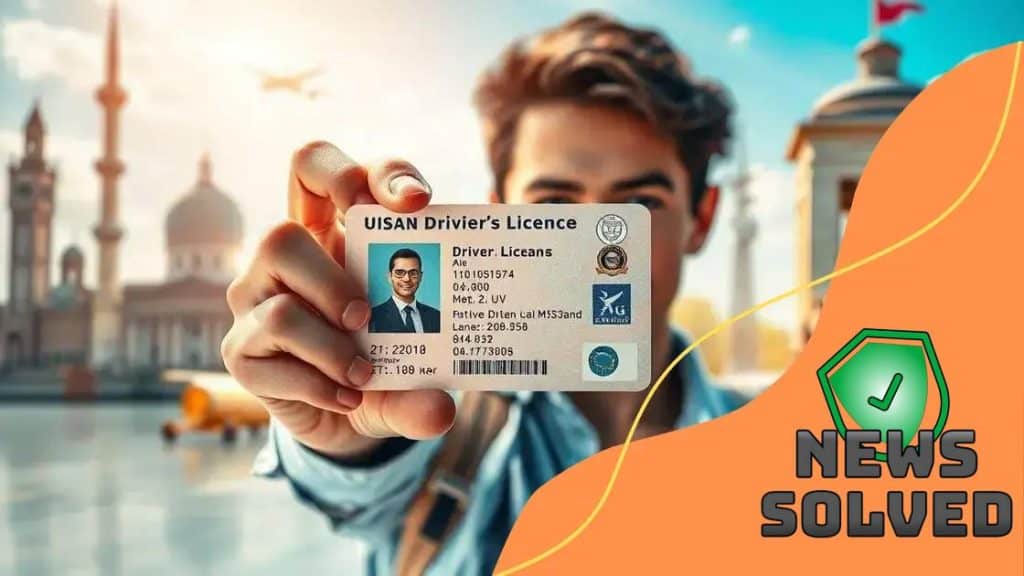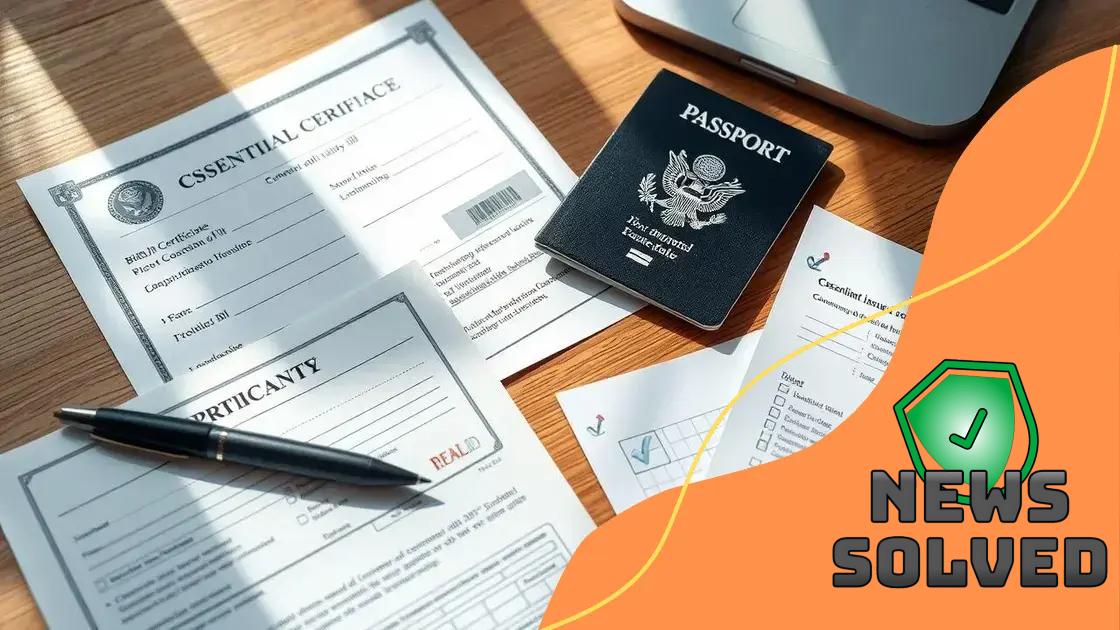Real ID enforcement May 2025: What you need to know

Advertisements
The Real ID is a federally compliant identification that individuals must obtain by May 3, 2023, to board domestic flights and access federal facilities, requiring specific documents to prove identity and residency.
Real ID enforcement May 2025 is just around the corner, and many might be wondering what this means for their travel. Are you ready for the changes ahead? Let’s dive into what you need to know.
Advertisements
Understanding the Real ID Act
The Real ID Act is a crucial piece of legislation that impacts how states issue driver’s licenses and identification cards. This act was enacted to enhance national security and prevent identity fraud.
Since its introduction, states have been working to comply with the guidelines set forth by the federal government. Understanding this act is important for ensuring you have the proper identification for travel.
What Is the Real ID Act?
The Real ID Act was passed by Congress in 2005 in response to recommendations from the 9/11 Commission. It requires states to improve the security of state-issued IDs.
Advertisements
Key Features of the Real ID Act
Some key features include:
- Stricter requirements for documentation when applying for an ID.
- Enhanced security features on IDs, such as biometric data.
- Standards for state facilities issuing IDs to ensure compliance.
As a result of the Real ID Act, travelers must now be more aware of what types of identification are acceptable for air travel.
State Compliance
Each state has taken steps to meet the standards of the act. However, the timeline for compliance varies significantly from one state to another. Keeping track of your state’s progress can help avoid disruptions in travel plans.
In essence, the Real ID Act not only aims to improve security but also helps streamline the identification process. Knowing what to expect can make navigating the new requirements easier for everyone.
Travelers should familiarize themselves with their state’s ID regulations, especially as the deadline approaches. Explore local resources or official websites for the most accurate information regarding compliance and necessary identification for traveling.
Key deadlines and compliance dates
When it comes to the Real ID enforcement, understanding the key deadlines and compliance dates is essential for every traveler. These dates are critical, as they help individuals prepare for the shift in identification requirements.
Important Deadlines
The government has set several important deadlines that all states must adhere to. Knowing these dates can prevent any last-minute issues, especially for travel plans. Here are some crucial deadlines to keep in mind:
- October 1, 2021: All states must begin issuing compliant IDs.
- May 3, 2023: Travelers will need a Real ID or alternative form of identification for domestic flights.
- Ongoing: States that fail to comply may restrict the use of their IDs at federal facilities.
Each state has its own timeline for fully implementing the Real ID Act. Some states already offer compliant IDs, while others are still in the process of meeting the requirements.
It’s important to check your state’s specific compliance dates. Not all states are adhering to the same schedule, which may affect your travel plans significantly.
Compliance Preparations
As deadlines approach, it’s wise to prepare in advance. Gather the necessary documentation early to ensure you meet the identification requirements. Consider keeping a checklist of the documents you will need:
- Proof of identity, such as a birth certificate or passport.
- Proof of residency, like a utility bill or lease agreement.
- Any legal documents necessary, that might validate your name change.
By staying aware of these key deadlines and preparing accordingly, you can navigate the Real ID enforcement smoothly. Make sure to keep a lookout for any updates from your state regarding compliance timelines and ID issuance processes.
What documents you’ll need to prepare

Preparing for the Real ID enforcement involves understanding the necessary documents you’ll need. Having the right paperwork is essential to obtain a compliant identification card.
First, it is important to note that different states may have varying requirements, but there are common documents that most states will ask for. Gathering these ahead of time can simplify the process.
Main Documents Required
Generally, you will need to present specific types of documents at your local DMV or ID issuing office. Here’s a list of the main categories:
- Proof of Identity: This could be a birth certificate, U.S. passport, or military ID.
- Proof of Residency: You may need a utility bill, lease, or bank statement with your name and address.
- Legal Documents: If your name has changed, provide a marriage certificate or court papers.
Each type of document plays a critical role in proving your identity and residency. It’s important to ensure that the documents you provide match the name and address you wish to have on your ID.
Additional Considerations
Also, think about personal circumstances that might require additional documentation. For example, if you’ve adopted children, you might need their adoption papers as proof of guardianship. If your documents are not in English, be prepared to provide certified translations.
As the deadline approaches, consider checking your state’s website for the most up-to-date requirements. This ensures that you are fully prepared when it’s time to acquire your Real ID.
Lastly, if you’re unsure about any documents, it can be helpful to call your local DMV office. They can clarify what you’ll need and advise you on the best way to gather everything in advance.
How Real ID affects travel plans
The implementation of Real ID requirements has a significant impact on travel plans for many people. As enforcement dates approach, understanding how these new regulations influence air travel and other forms of transportation is crucial.
Travelers will need to ensure they possess a compliant form of identification for flying within the United States. Without a Real ID or other acceptable forms of ID, individuals may face delays or even be unable to board their flights.
Impact on Air Travel
As the deadline for Real ID compliance nears, passengers should be aware of the following:
- New ID requirements will be needed for airport security checks.
- Travelers planning domestic flights must have a compliant ID by May 3, 2023.
- Those without a Real ID can still use a passport or another accepted form of identification.
This situation emphasizes the importance of checking ID status before making any travel plans. It is wise to verify that your ID is compliant well in advance of your trip.
Other Transportation Avenues
In addition to air travel, the Real ID requirements may also impact other modes of transportation such as trains and buses. While not all transit systems require a compliant ID, being without proper ID could cause disruptions or delays when verifying identity.
Furthermore, if planning to rent a car, having a Real ID may be key, as agencies often require valid identification to pick up your rental. Travelers should confirm rental policies to avoid any surprises.
Overall, staying informed about Real ID requirements is essential for smooth and efficient travel. By ensuring your identification meets the necessary standards, you can minimize potential stress and complications during your journey.
Alternatives to Real ID
If you are unable to obtain a Real ID or prefer not to, there are alternatives that you can use for identification, especially when traveling. Understanding these options is crucial for ensuring smooth travel without disruptions.
While the Real ID will be required for domestic flights starting May 3, 2023, travelers can still utilize several other forms of identification to meet requirements.
Acceptable Alternatives
Here are the main alternatives to a Real ID:
- U.S. Passport: A valid passport can be used for air travel and is widely accepted.
- Military ID: Those with a military identification card can use it for both travel and access to secure facilities.
- Global Entry Card: This card is not only helpful for international travel but is also a valid form of ID for domestic flights.
These alternatives provide flexibility, but it’s important to check the expiration dates and validity to ensure they meet the necessary requirements.
State-Specific Options
Additionally, some states might offer their own versions of identification that can serve as a compliant alternative. It’s essential to check with your state’s DMV or equivalent agency to learn about any specific options available.
Remember, even though alternatives exist, they must be valid and compliant with federal regulations. Keeping an updated passport or exploring state-specific IDs can make for smoother travel experiences.
Lastly, if you’re traveling internationally, a passport will always be essential. Thus, having a valid passport is advisable even if you possess a Real ID.
Myths and facts about Real ID enforcement

There are many myths surrounding Real ID enforcement that can create confusion. Understanding the facts is crucial for navigating this important change effectively.
One common myth is that a Real ID will be required for all forms of identification. In reality, while the Real ID is necessary for boarding domestic flights, there are other acceptable forms of ID as well.
Common Myths
Here are a few myths versus facts regarding Real ID enforcement:
- Myth: Every state has the same deadlines for Real ID compliance.
Fact: Compliance dates vary by state, so it’s vital to check local regulations. - Myth: A Real ID is more expensive to obtain than a regular ID.
Fact: Costs are typically similar, though additional fees may apply in some states. - Myth: You will automatically receive a Real ID when renewing your current ID.
Fact: You must specifically request a Real ID during the application process.
Awareness of these myths helps individuals prepare better for upcoming requirements. By distinguishing fact from fiction, you can avoid unnecessary confusion and ensure you meet the necessary criteria.
Understanding What You Need
To avoid misinformation, familiarize yourself with your state’s Department of Motor Vehicles (DMV) website. This site will provide both the latest guidelines and the necessary procedures for obtaining a Real ID.
Don’t hesitate to ask for clarification if you have questions about the Real ID Act. Getting the facts straight will help you navigate the changes smoothly and avoid any potential issues while traveling.
FAQ – Common Questions about Real ID Enforcement
What is a Real ID?
A Real ID is a federally compliant identification that is required for certain activities like boarding domestic flights and accessing federal facilities.
When will I need a Real ID?
You will need a Real ID to fly domestically starting May 3, 2023, unless you have another acceptable form of identification.
What type of documents do I need to obtain a Real ID?
To get a Real ID, you’ll need documents that prove your identity, residency, and any name changes, such as a birth certificate, utility bill, and marriage certificate.
What if I cannot get a Real ID?
If you cannot get a Real ID, you can still use other forms of ID, such as a U.S. passport or military ID, for travel and identification purposes.





